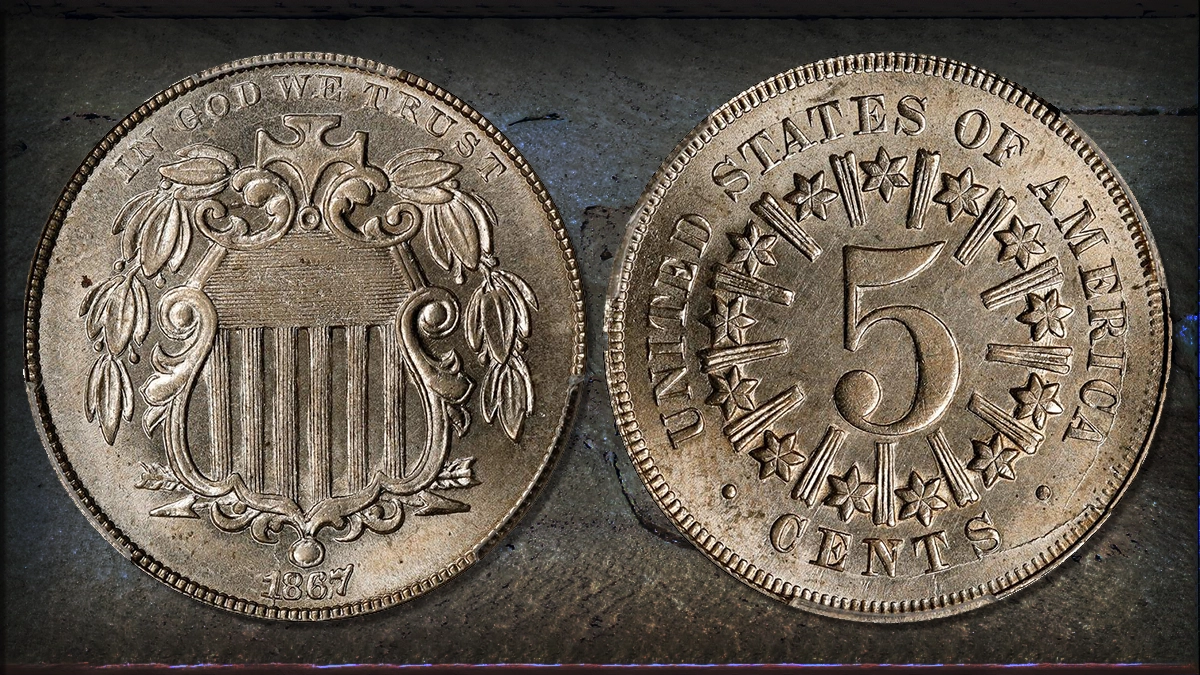
Introduced following the end of the Civil War, the Shield nickel was the nation’s first five-cent piece with nickel metal content. The coin was proposed at least partly in response to the public’s (and United States Mint Director James Pollock’s) growing dislike of fractional currency.
Even though there were already more than half a dozen small denomination coins in circulation, most were not actually circulating due to coin hoarding that continued to occur after the war’s end. Director Pollock had previously been opposed to nickel-content coinage because the hard metal was tough on dies and mint machinery. But he thought hat a new five-cent coin could be a temporary measure to replace the disliked fractional notes, perhaps marking time until the silver half-dime again returned to general circulation.
Politics were in play, however, with the owner of America’s largest nickel mine a frequent and persuasive lobbyist for the increased use of nickel in circulating coinage. Other non-technical issues also influenced the design of the coin, including a little-promoted specification that the coin’s weight be in metric rather than English units. In addition, several pattern coins were made with profiles of presidents Washington and Lincoln, but unresolved concerns over using portraits on coins led Chief Engraver James B. Longacre to instead use a modified version of a design he had used on the two-cent piece. The design was initially criticized both for its design and because some thought the reverse reminiscent of the Confederate “stars and bars” motif.
In 1867 the design was revised to remove the rays. This was done to increase die life.
How Are Shield Nickels Collected?
Business strike Shield nickels With Rays are generally affordable up through lower Mint State grades, but prices spike at Gem level. Because design details are often weak due to striking difficulty, sharply struck coins can be a challenge to find. Coins showing die cracks, caused by the resistance of the hard blanks against the dies, are interesting and not uncommon but generally do not result in higher or lower prices compared to regular coins. Though minted in substantially fewer numbers, 1867-dated coins have only a modest premium over those from 1866, until the higher Mint States. A repunched 1866 date commands a significantly higher premium and is represented by far fewer examples in population/census reports.

Proofs include both Cameo and Deep/Ultra Cameo (1866 only) grades, with Deep/Ultra Cameo at higher grades being more expensive. While 1866 Proofs are not plentiful at a total of about 500 coins, 1867 Proofs are considered rare at only 25 to 75 coins (estimates vary), are a key coin of the series and as such are more than 10 times as expensive as the 1866 Proofs.
Varieties
The Shield nickel series is extensively studied, and includes multiple variations such as repunched dates and doubling on the obverse (shield) side.
Design
Obverse:
The Shield nickel has dentils along the rim of both sides. Since all were struck at the Philadelphia Mint, none display a mint mark. The obverse has the motto “In God We Trust” along the top periphery of the field, with the date centered at the bottom. In the center is an ornamented shield, topped with a symbolic cross (often described as the cross of the Order of Calatrava, an old military/religious order in Spain, though this attribution is subject to debate), flanked on both sides by laurel leaves, and lying above and in front of two crossed arrows at the bottom.
Reverse:
The reverse has the words “United States of America” around little more than the top half of the periphery, with the word “Cents” at the bottom edge. Two dots, one on each side, are equally spaced between the two text legends. A large numeral 5 is in the center, from which 13 six-point stars alternate with 13 rays (originally called bars), radiating outward from the 5 to form an encircling wreath between the 5 and the text along the rim. Proof 1866 coins have a center dot that is visible on both sides.
Edge:
The edge of the Shield nickel With Rays is plain or smooth, without reeding or edge lettering.
Coin Specifications
| Shield Nickels, With Rays | |
| Years Of Issue: | 1867-1883 |
| Mintage (Circulation): | High: 14,742,500 (1866); Low: 2,019,000 (1867) |
| Mintage (Proof): | High: 500 (1866); Low: 75, estimated (1867) |
| Alloy: | 75% nickel, 25% copper |
| Weight: | 5.0 g |
| Diameter: | 20.5 mm |
| Edge: | Plain |
| OBV Designer | James Barton Longacre |
| REV Designer | James Barton Longacre |
* * *
References
Bowers, Q. David. The Experts Guide to Collecting & Investing in Rare Coins. Whitman Publishing.
–. A Guide Book of Shield and Liberty Head Nickels. Whitman Publishing.
–. A Guide Book of United States Type Coins. Whitman Publishing.
Breen, Walter. Walter Breen’s Complete Encyclopedia of United States Coins. Doubleday.
Taxay, Don. The U.S. Mint and Coinage. Arco Publishing.
Yeoman, R.S and Jeff Garrett (editor). The Official Red Book: A Guide Book of United States Coins. Whitman Publishing.
* * *




